Nonlinear Dynamic Response of a Precast Concrete Building to Sudden Column Removal
Abstract
:1. Introduction
2. Case Study and Modelling Technique
2.1. Description of the Case Study
2.2. FE Modelling and Analysis Technique
- An isotropic hardening quadrilinear asymmetric relation was assigned to the connection moment–rotation behavior;
- An isotropic hardening quadrilinear symmetric relation was assigned to the connection shear-displacement behavior.
- PC2: the only connections modelled as links are used, neglecting the tying rebars.
- Gravity loads were applied to the structure through distributed masses along beam and column members;
- The designated column was dynamically removed until the structural equilibrium was achieved or not.
2.2.1. Shear-Displacement Relationship for Translational Spring
2.2.2. Moment–Rotation Relationship for Rotational Spring
- The joint opening at the interface due to yield elongation of continuous reinforcing bars (or the achievement of the shear force of the dowel):
- The column rotation on top and bottom of the joint zone:where hcol is equal to the column height and Icol is the second moment of inertia of columns [52]. The last two contributions were assumed to be constant [52]. Considering the steel strain hardening ratio k and fracture strain εsu, the connection ultimate moment MRcu and rotation θRcu was easily calculated. Table 2 provides a summary of the calculation related to joint detail in Figure 1c with dT = 650 mm.
3. Performance Limit States Related to Column Loss Scenarios
- PLS1: tie or connection yielding. At this stage, the connections start to resist to applied loads in the inelastic range;
- PLS2: dowel fracture. At this stage, the dowel shear strength is lost, and the resistance to applied loads relies on continuous reinforcements;
- PLS3: tie or connection fracture. At this stage, the fracture of connection subject to negative moment or the tie fracture elongation is achieved;
- PLS4: loss of support. At this stage, precast beams experience a lateral displacement which is larger than a threshold value corresponding to a prescribed limit of support width.
- Achievement of longitudinal rebar yield strain. At this stage, structural members start to resist to applied loads in the inelastic range;
- Achievement of concrete compressive peak stress;
- Achievement of maximum axial load acting on beams above the removed column. This indicator is significant to assess the onset catenary action resisting mechanism;
- Achievement of maximum tensile longitudinal rebar elongation. At this stage, the tensile rebars achieve maximum strain, which could correspond to the fracture strain.
4. Results and Discussion
4.1. Edge Column Removal Scenario
4.1.1. Moment Resisting Frame System (MRF_E)
4.1.2. Precast Frame System (PCF_E)
- PLS1 was reached because of the yielding of all ties and all negative moment spring at each floor level;
- PLS2 was reached because of fracture of all dowels at each floor level. This indicates that the structural response relies on the flexural contributions of rotational springs and tying reinforcements;
- PLS3 was reached because of some tie fractures at the second floor level in correspondence of removed column (T2-2 and T2-3 locations) immediately followed by an additional tie fracture at the first floor level (T1-2 location);
- Due to the above-mentioned tie fractures, the structure lost the support at the first and second floor levels (T1-2, T2-2 and T2-3 locations), indicating that a progressive collapse was occurring. PLS4 was thus reached.
- The yield of all tie reinforcements as well as all negative branch of rotational spring were achieved at each floor level (PLS1);
- The fracture of all dowels was achieved at each floor level, indicating that the structural response relied on the flexural contributions of rotational springs and tying reinforcement (PLS2);
- Some tie fractures were detected at the second floor level in correspondence of removed column (T2-2 and T2-3 locations), indicating the occurrence of PLS3;
- Due to the above-mentioned tie fractures confined to the second floor only, no support loss was detected. Hence, in this case, progressive collapse did not occur (i.e., PLS4 was not reached).
4.2. Interior Column Removal Scenario
4.2.1. Moment Resisting Frame System (MRF_I)
4.2.2. Precast Frame System (PCF_I)
4.3. Corner Column Removal Scenario
4.3.1. Moment Resisting Frame System (MRF_C)
4.3.2. Precast Frame System (PCF_C)
4.4. Summary of Results
5. Conclusions
- In general, precast concrete frame structures have poorer progressive collapse performance compared to moment resisting frame structures. Improvements to structural robustness could be achieved through a careful design of beam-to-column connections and tying system, eventually considering the floor slab resisting contribution.
- A fundamental role is played by the tying system, which can sustain considerable vertical loads even after the dowel connection loses its lateral strength. On the contrary, the absence of tying systems leads to the total collapse of the precast concrete system, which is not able to sustain even its own self-weight.
- Performance levels have been proposed for progressive collapse analysis of precast concrete structures. Specifically, the support loss, which can occur during column removal scenarios, is considered the main indicator of progressive collapse. Indeed, this study demonstrated that, although the fracture of dowels and ties occurs, the structure could be able to sustain vertical loads. In engineering practice, attention should be given to subsequent events occurring during progressive collapse simulation. Occurrence of brittle failures should also be checked.
- The influence of material properties (such as fracture strain of steel) on structural performance should be investigated as well as precast connection configurations. Moreover, the set of notional column-removal scenarios should be expanded by considering single or multiple element loss at different locations in plan and elevation. Such parametric investigations will be explored in future research as made, e.g., in recent studies on cast-in-situ reinforced concrete frames [55].
- Simplified numerical simulations carried out in this study allow an accurate representation of the main events occurring during a progressive collapse phenomenon. In spite of this, detailed finite element simulations are required from a multi-scale modelling point of view. More in detail, the resisting contribution of the floor slab, distributed tying systems and beam-column-slab connections are considered important issues to be investigated in future research. Experimental campaigns and numerical investigations are still required to evaluate the robustness of different precast concrete structures. The contribution of different diaphragm typologies is still lacking in the literature.
Author Contributions
Funding
Data Availability Statement
Conflicts of Interest
References
- Adam, J.M.; Parisi, F.; Sagaseta, J.; Lu, X. Research and practice on progressive collapse and robustness of building structures in the 21st century. Eng. Struct. 2018, 173, 122–149. [Google Scholar] [CrossRef]
- Eurocode 1—Actions on Structures: General Actions—Accidental Actions; CEN-EC1, EN 1991-1-7; European Committee for Standardization: Brussels, Belgium, 2006.
- Qian, K.; Li, B.; Ma, J.-X. Load-Carrying Mechanism to Resist Progressive Collapse of RC Buildings. J. Struct. Eng. 2015, 141, 04014107. [Google Scholar] [CrossRef]
- Lim, N.S.; Tan, K.; Lee, C. Effects of rotational capacity and horizontal restraint on development of catenary action in 2-D RC frames. Eng. Struct. 2017, 153, 613–627. [Google Scholar] [CrossRef]
- Yu, J.; Tan, K.H. Structural Behavior of RC Beam-Column Subassemblages under a Middle Column Removal Scenario. J. Struct. Eng. 2013, 139, 233–250. [Google Scholar] [CrossRef]
- Pham, A.T.; Tan, K.H. Static and Dynamic Responses of Reinforced Concrete Structures under Sudden Column Removal Scenario Subjected to Distributed Loading. J. Struct. Eng. 2019, 145. [Google Scholar] [CrossRef]
- Lew, H.S.; Bao, Y.; Pujol, S.; Sozen, M.A. Experimental Study of Reinforced Concrete Assemblies under a Column Removal Scenario. ACI Struct. J. 2014, 111, 881–892. [Google Scholar] [CrossRef]
- Pham, A.T.; Tan, K.H. Experimental study on dynamic responses of reinforced concrete frames under sudden column removal applying concentrated loading. Eng. Struct. 2017, 139, 31–45. [Google Scholar] [CrossRef]
- Yu, J.; Tan, K.H. Structural Behavior of Reinforced Concrete Frames Subjected to Progressive Collapse. ACI Struct. J. 2017, 114, 63–74. [Google Scholar] [CrossRef]
- Diao, M.; Li, Y.; Guan, H.; Lu, X.; Gilbert, B.P. Influence of horizontal restraints on the behaviour of vertical disproportionate collapse of RC moment frames. Eng. Fail. Anal. 2020, 109. [Google Scholar] [CrossRef]
- Dat, P.X.; Tan, K.H. Experimental Response of Beam-Slab Substructures Subject to Penultimate-External Column Removal. J. Struct. Eng. 2015, 141, 04014170. [Google Scholar] [CrossRef]
- Dat, P.X.; Tan, K.H. Experimental study of beam–slab substructures subjected to a penultimate-internal column loss. Eng. Struct. 2013, 55, 2–15. [Google Scholar] [CrossRef]
- Lu, X.; Lin, K.; Li, Y.; Guan, H.; Ren, P.; Zhou, Y. Experimental investigation of RC beam-slab substructures against progressive collapse subject to an edge-column-removal scenario. Eng. Struct. 2017, 149, 91–103. [Google Scholar] [CrossRef]
- Lim, N.S.; Tan, K.; Lee, C. Experimental studies of 3D RC substructures under exterior and corner column removal scenarios. Eng. Struct. 2017, 150, 409–427. [Google Scholar] [CrossRef] [Green Version]
- Yu, J.; Luo, L.-Z.; Fang, Q. Structure behavior of reinforced concrete beam-slab assemblies subjected to perimeter middle column removal scenario. Eng. Struct. 2020, 208, 110336. [Google Scholar] [CrossRef]
- Qian, K.; Li, B. Resilience of Flat Slab Structures in Different Phases of Progressive Collapse. ACI Struct. J. 2016, 113, 537–548. [Google Scholar] [CrossRef]
- Xue, H.; Gilbert, B.; Guan, H.; Lu, X.; Li, Y.; Ma, F.; Tian, Y. Load Transfer and Collapse Resistance of RC Flat Plates under Interior Column Removal Scenario. J. Struct. Eng. 2018, 144, 04018087. [Google Scholar] [CrossRef] [Green Version]
- Yi, W.; Zhang, F.-Z.; Kunnath, S.K. Progressive Collapse Performance of RC Flat Plate Frame Structures. J. Struct. Eng. 2014, 140, 04014048. [Google Scholar] [CrossRef]
- Ravasini, S.; Scalvenzi, M.; Parisi, F.; Belletti, B.; Gasperi, A. Evaluation of structural robustness of precast RC structures. In Proceedings of the Italian Concrete Days 2020, Napoli, Italy, 14–16 April 2020. [Google Scholar]
- Kang, S.B.; Tan, K.H. Behaviour of precast concrete beam–column sub-assemblages subject to column removal. Eng. Struct. 2015, 93, 85–96. [Google Scholar] [CrossRef]
- Kang, S.B.; Tan, K.H. Progressive Collapse Resistance of Precast Concrete Frames with Discontinuous Reinforcement in the Joint. J. Struct. Eng. 2017, 143, 04017090. [Google Scholar] [CrossRef]
- Zhou, Y.; Chen, T.; Pei, Y.; Hwang, H.-J.; Hu, X.; Yi, W.; Deng, L. Static load test on progressive collapse resistance of fully assembled precast concrete frame structure. Eng. Struct. 2019, 200, 109719. [Google Scholar] [CrossRef]
- Feng, F.-F.; Hwang, H.-J.; Yi, W. Static and dynamic loading tests for precast concrete moment frames under progressive collapse. Eng. Struct. 2020, 213, 110612. [Google Scholar] [CrossRef]
- Qian, K.; Liang, S.-L.; Xiong, X.-Y.; Fu, F.; Fang, Q. Quasi-static and dynamic behavior of precast concrete frames with high performance dry connections subjected to loss of a penultimate column scenario. Eng. Struct. 2020, 205. [Google Scholar] [CrossRef]
- Nimse, R.B.; Joshi, D.D.; Patel, P.V. Behavior of wet precast beam column connections under progressive collapse scenario: An experimental study. Int. J. Adv. Struct. Eng. 2014, 6, 149–159. [Google Scholar] [CrossRef] [Green Version]
- Joshi, D.D.; Patel, P.V.; Rangwala, H.M.; Patoliya, B.G. Experimental and numerical studies of precast connection under progressive collapse scenario. Adv. Concr. Constr. 2020, 9, 235–248. [Google Scholar]
- Zhang, W.-X.; Wu, H.; Zhang, J.-Y.; Hwang, H.-J.; Yi, W.-J. Progressive collapse test of assembled monolithic concrete frame spatial substructures with different anchorage methods in the beam–column joint. Adv. Struct. Eng. 2020, 23, 1785–1799. [Google Scholar] [CrossRef]
- Wang, F.; Yang, J.; Shah, S. Effect of Horizontal Restraints on Progressive Collapse Resistance of Precast Concrete Beam-Column Framed Substructures. KSCE J. Civ. Eng. 2020, 879–889. [Google Scholar] [CrossRef]
- Almusallam, T.H.; Elsanadedy, H.M.; Al-Salloum, Y.; Siddiqui, N.A.; Iqbal, R.A. Experimental Investigation on Vulnerability of Precast RC Beam-column Joints to Progressive Collapse. KSCE J. Civ. Eng. 2018, 22, 3995–4010. [Google Scholar] [CrossRef]
- Qian, K.; Li, B. Investigation into Resilience of Precast Concrete Floors against Progressive Collapse. ACI Struct. J. 2019, 116, 171–182. [Google Scholar] [CrossRef]
- Qian, K.; Li, B. Performance of Precast Concrete Substructures with Dry Connections to Resist Progressive Collapse. J. Perform. Constr. Facil. 2018, 32, 04018005. [Google Scholar] [CrossRef]
- Qian, K.; Li, B. Strengthening and Retrofitting Precast Concrete Buildings to Mitigate Progressive Collapse Using Externally Bonded GFRP Strips. J. Compos. Constr. 2019, 23. [Google Scholar] [CrossRef]
- Tohidi, M.; Baniotopoulos, C. Effect of floor joint design on catenary actions of precast floor slab system. Eng. Struct. 2017, 152, 274–288. [Google Scholar] [CrossRef]
- Design of Precast Concrete Structures Against Accidental Actions; fib Bulletin 63; International Federation for Structural Concrete: Lausanne, Switzerland, 2012.
- Structural Connections for Precast Concrete Buildings; fib Bulletin 43; International Federation for Structural Concrete: Lausanne, Switzerland, 2008.
- Parisi, F.; Augenti, N. Influence of seismic design criteria on blast resistance of RC framed buildings: A case study. Eng. Struct. 2012, 44, 78–93. [Google Scholar] [CrossRef]
- Quiel, S.; Naito, C.J.; Fallon, C.T. A non-emulative moment connection for progressive collapse resistance in precast concrete building frames. Eng. Struct. 2019, 179, 174–188. [Google Scholar] [CrossRef]
- Lin, K.; Lu, X.; Li, Y.; Guan, H. Experimental study of a novel multi-hazard resistant prefabricated concrete frame structure. Soil Dyn. Earthq. Eng. 2019, 119, 390–407. [Google Scholar] [CrossRef]
- Clementi, F.; Scalbi, A.; Lenci, S. Seismic performance of precast reinforced concrete buildings with dowel pin connections. J. Build. Eng. 2016, 7, 224–238. [Google Scholar] [CrossRef]
- Belleri, A.; Brunesi, E.; Nascimbene, R.; Pagani, M.; Riva, P. Seismic Performance of Precast Industrial Facilities Following Major Earthquakes in the Italian Territory. J. Perform. Constr. Facil. 2015, 29, 04014135. [Google Scholar] [CrossRef] [Green Version]
- Ghayeb, H.H.; Razak, H.A.; Sulong, N.H.R. Performance of dowel beam-to-column connections for precast concrete systems under seismic loads: A review. Constr. Build. Mater. 2020, 237, 117582. [Google Scholar] [CrossRef]
- Brunesi, E.; Nascimbene, R. Extreme response of reinforced concrete buildings through fiber force-based finite element analysis. Eng. Struct. 2014, 69, 206–215. [Google Scholar] [CrossRef]
- Parisi, F.; Scalvenzi, M.; Brunesi, E. Performance limit states for progressive collapse analysis of reinforced concrete framed buildings. Struct. Concr. 2018, 20, 68–84. [Google Scholar] [CrossRef] [Green Version]
- Design of Buildings to Resist Progressive Collapse; UFC 4-023-03; Department of Defense Unified Facilities Criteria: Washington, DC, USA, 2009.
- EN 1990 Eurocode 0: Basis of Structural Design; European Committee for Standardization: Brussels, Belgium, 2002.
- Seismosoft. Seismostruct—A Computer Program for Static and Dynamic Nonlinear Analysis of Framed Structures. Available online: https://seismosoft.com/ (accessed on 31 December 2020).
- Spacone, E.; Filippou, F.C.; Taucer, F.F. Fibre beam-column model for non-linear analysis of R/C frames: Part I. Formulation. Earthq. Eng. Struct. Dyn. 1996, 25, 711–725. [Google Scholar] [CrossRef]
- Mander, J.B.; Priestley, M.J.N.; Park, R. Theoretical Stress-Strain Model for Confined Concrete. J. Struct. Eng. 1988, 114, 1804–1826. [Google Scholar] [CrossRef] [Green Version]
- Bischoff, P.H.; Perry, S.H. Compressive behaviour of concrete at high strain rates. Mater. Struct. 1991, 24, 425–450. [Google Scholar] [CrossRef]
- El Debs, M.K.; Miotto, A.M.; El Debs, A.L.H.C. Analysis of a semi-rigid connection for precast concrete. Proc. Inst. Civ. Eng. Struct. Build. 2010, 163, 41–51. [Google Scholar] [CrossRef]
- Elliott, K.S.; Davies, G.; Ferreira, M.; Gorgun, H.; Mahdi, A.A. Can precast concrete structures be designed as semi-rigid frames? Part 1—The experimental evidence. Struct. Eng. 2003, 81, 14–27. [Google Scholar]
- Elliott, K.S.; Davies, G.; Ferreira, M.; Gorgun, H.; Mahdi, A.A. Can precast concrete structures be designed as semi-rigid frames? Part 2—Analytical equations & column effective length factors. Struct. Eng. 2003, 81, 28–37. [Google Scholar]
- EN 1998: Eurocode 8: Design of Structures for Earthquake Resistance—Part 1: General Rules, Seismic Actions and Rules for Buildings; CEN-EC8; European Committee for Standardization: Brussels, Belgium, 2004.
- Belletti, B.; Franceschini, L.; Ravasini, S. Tie force method for reinforced concrete structures. In Proceedings of the International fib Symposium on Conceptual Design of Structures, Madrid, Spain, 26–28 September 2019; Volume 1, pp. 57–64. [Google Scholar]
- Parisi, F.; Scalvenzi, M. Progressive collapse assessment of gravity-load designed European RC buildings under multi-column loss scenarios. Eng. Struct. 2020, 209, 110001. [Google Scholar] [CrossRef]

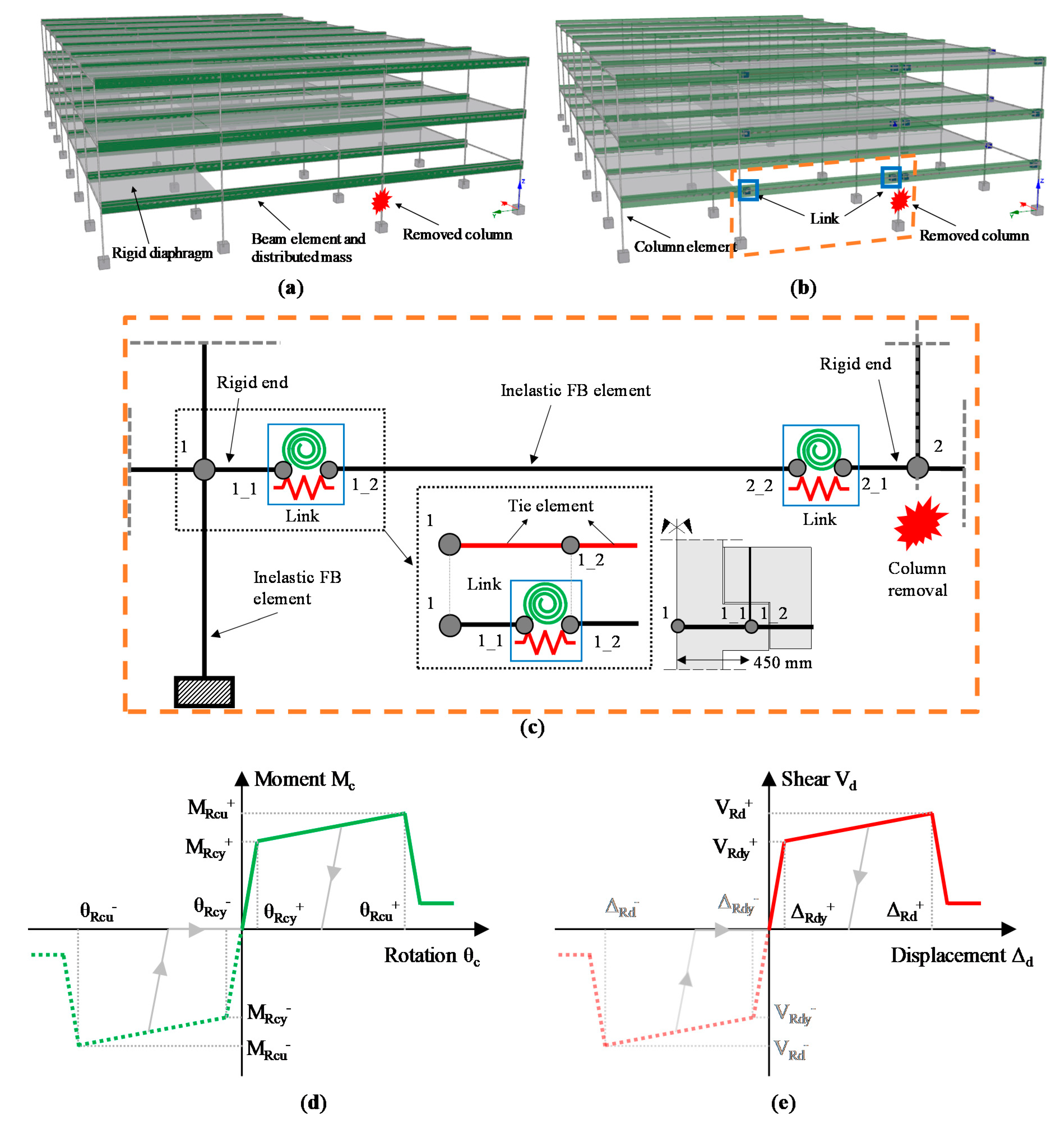
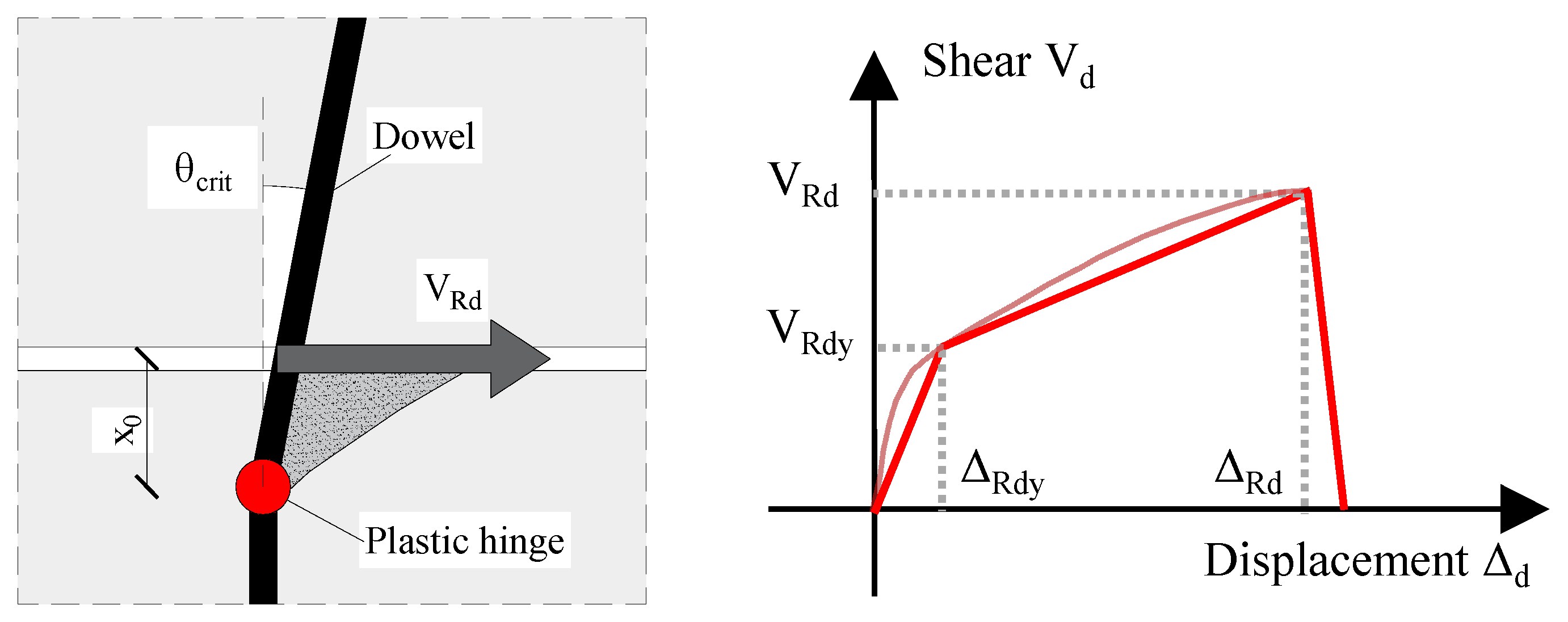
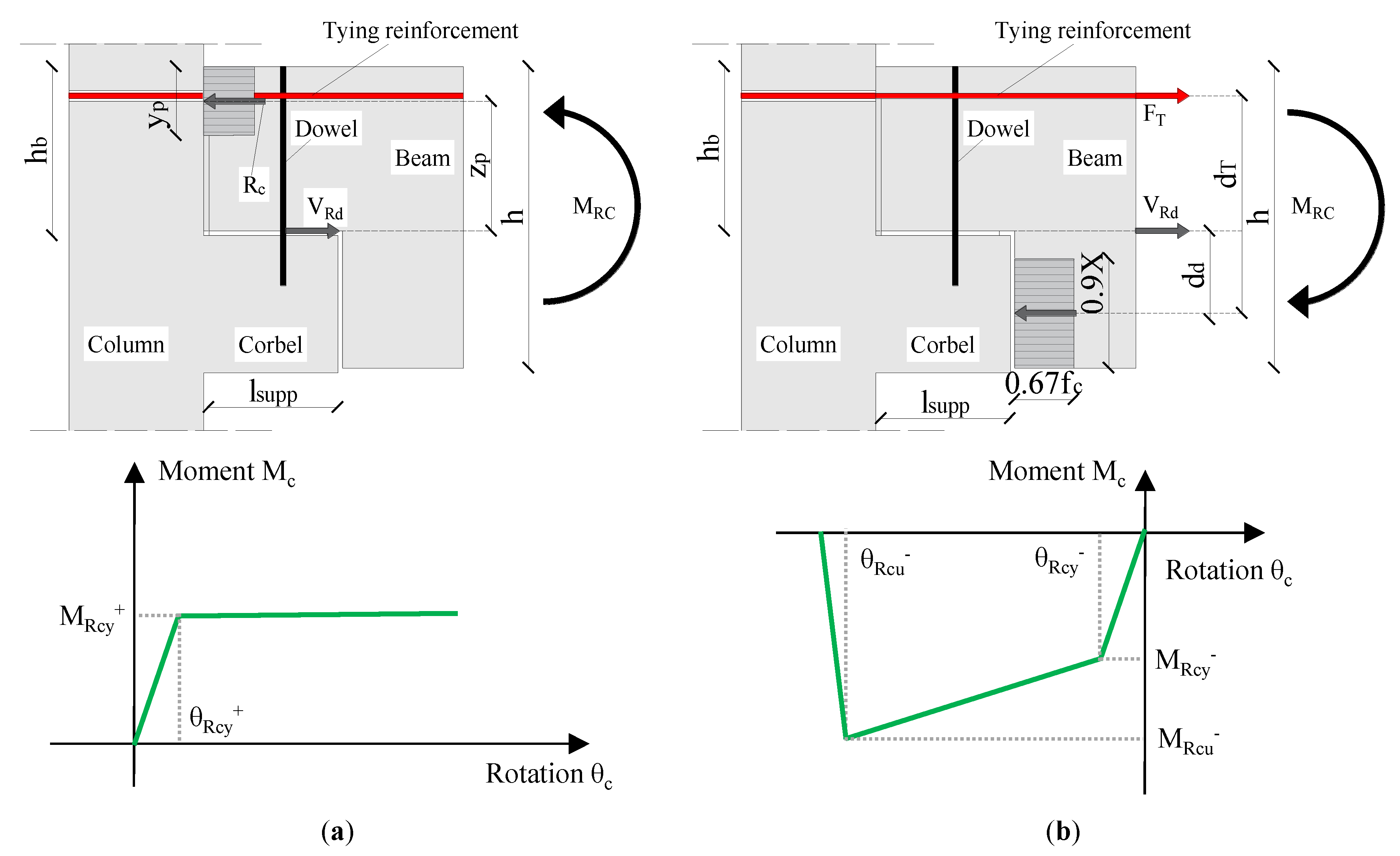
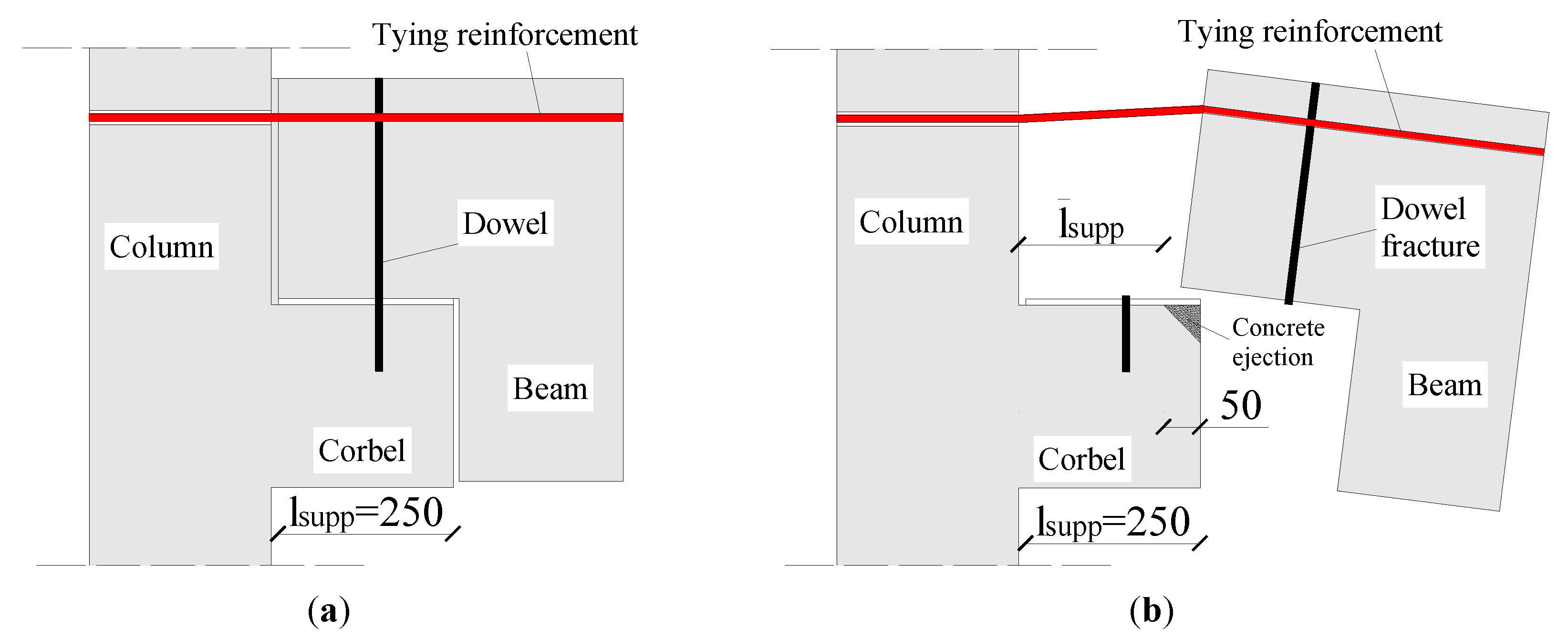
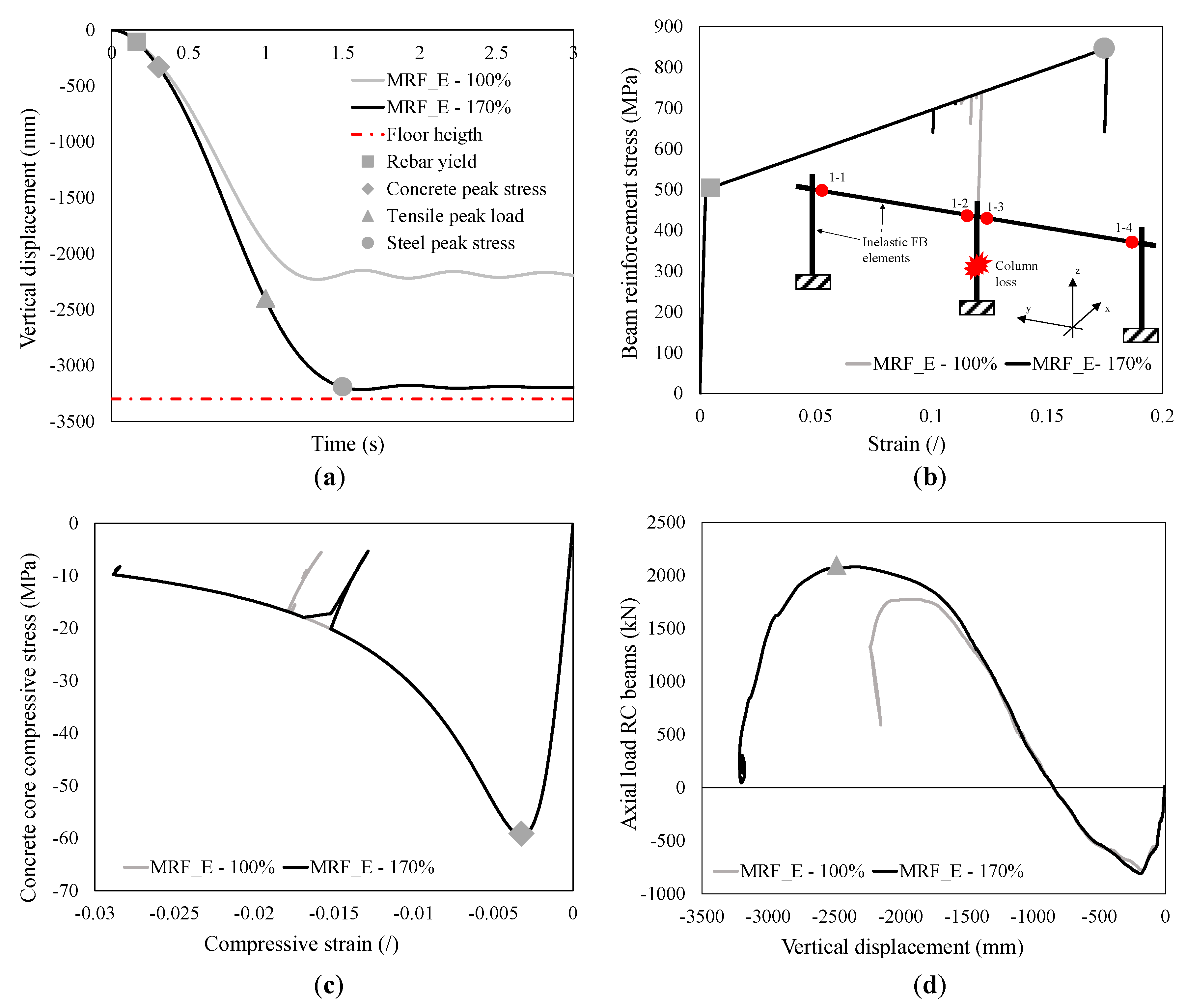
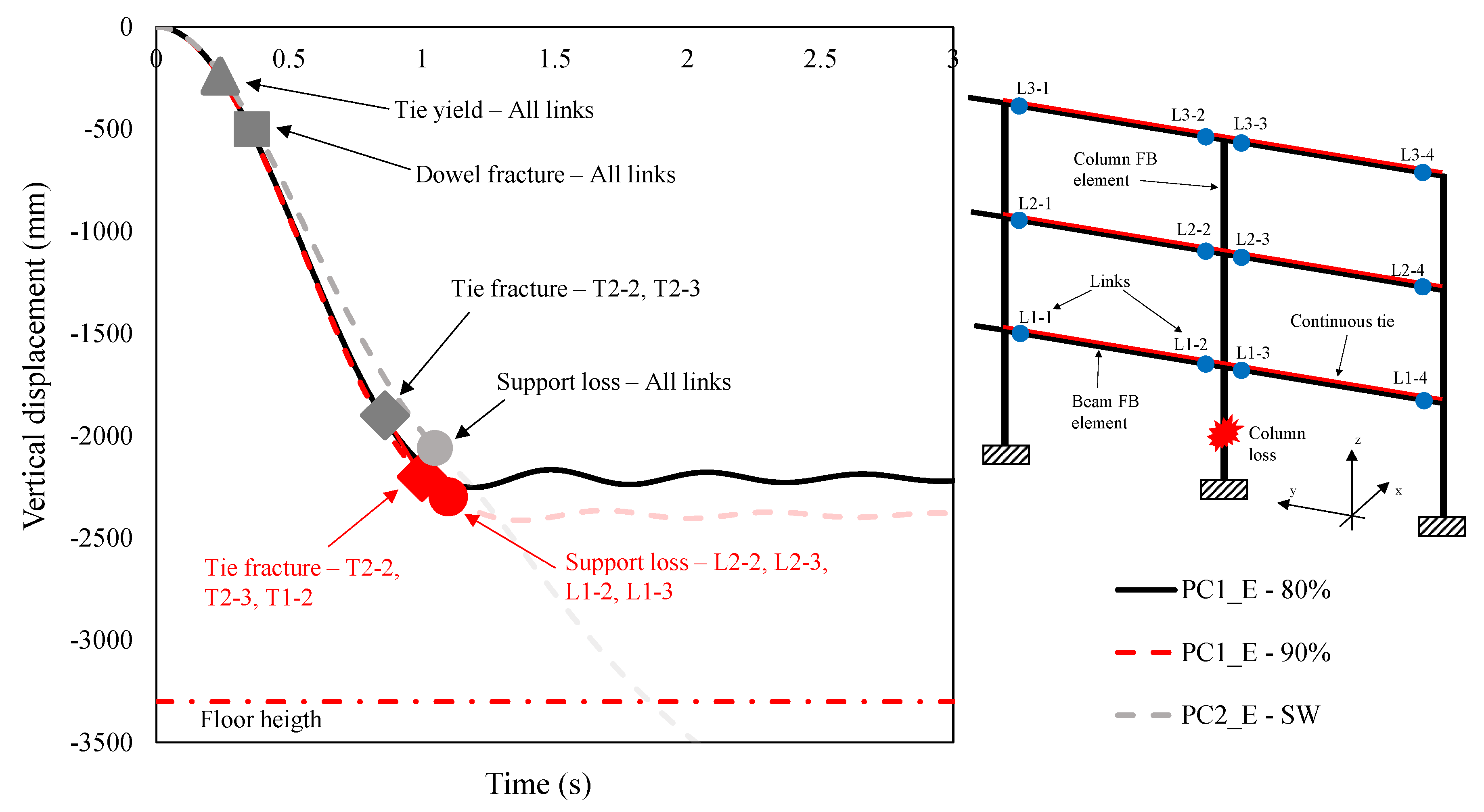
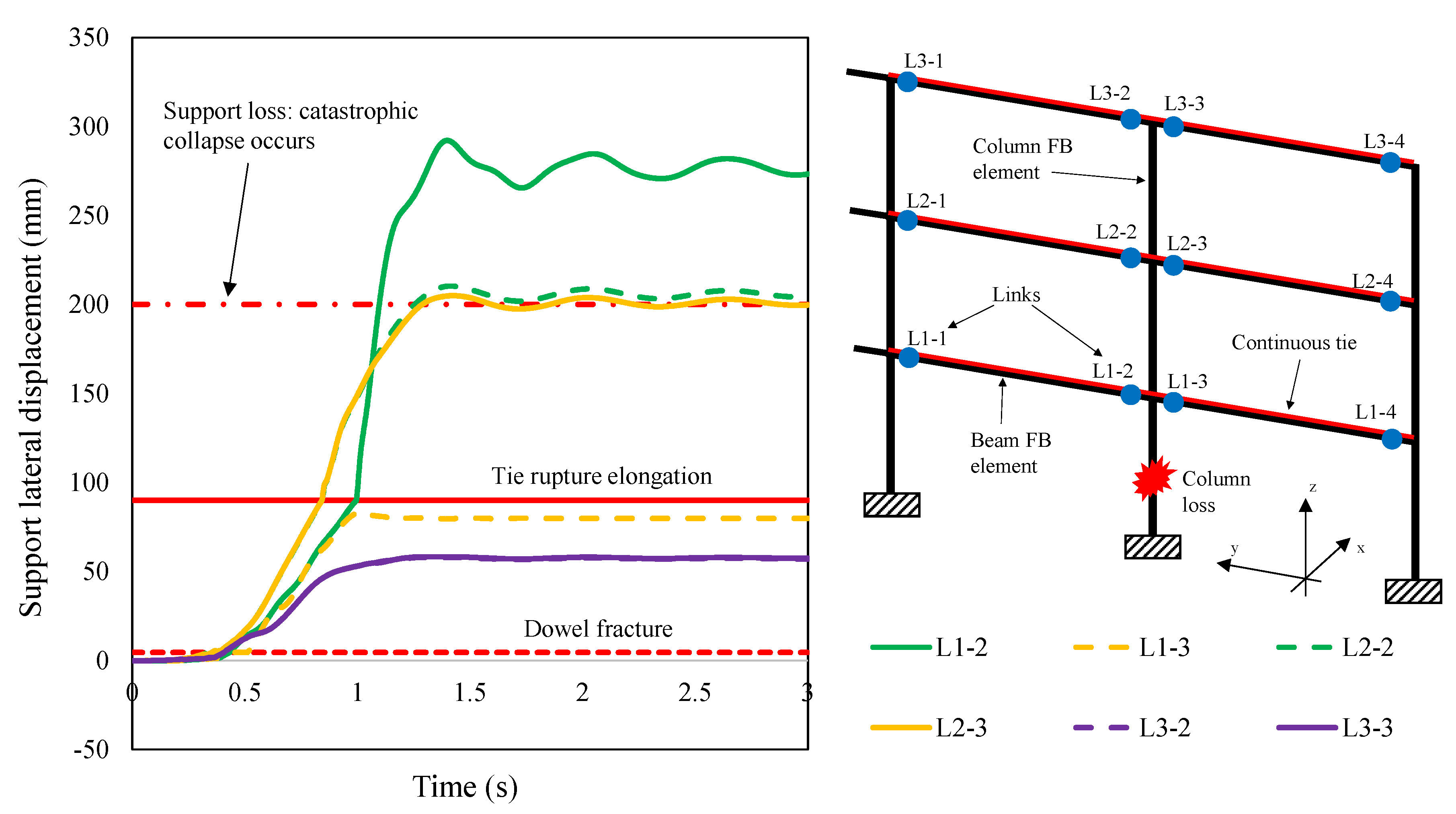
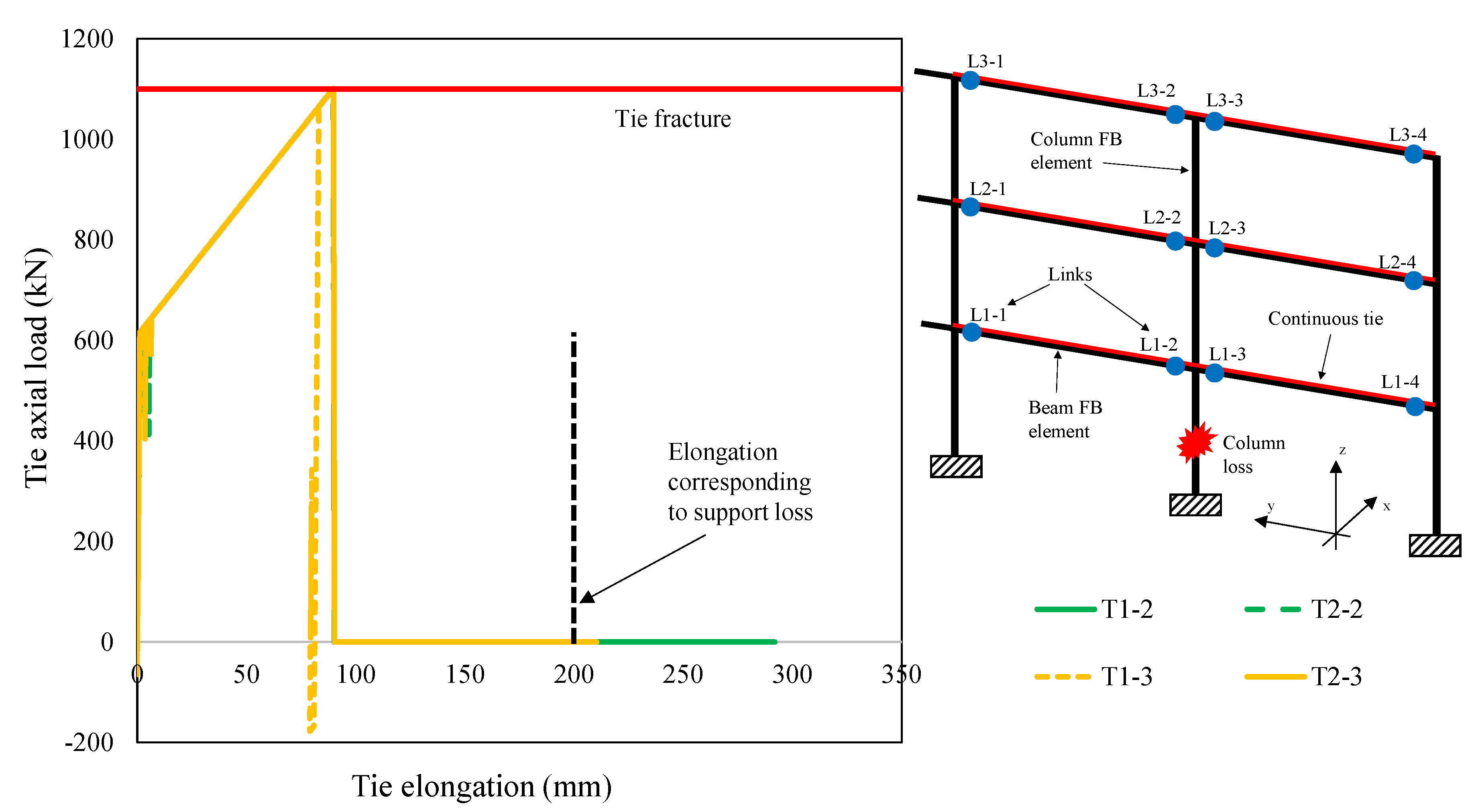


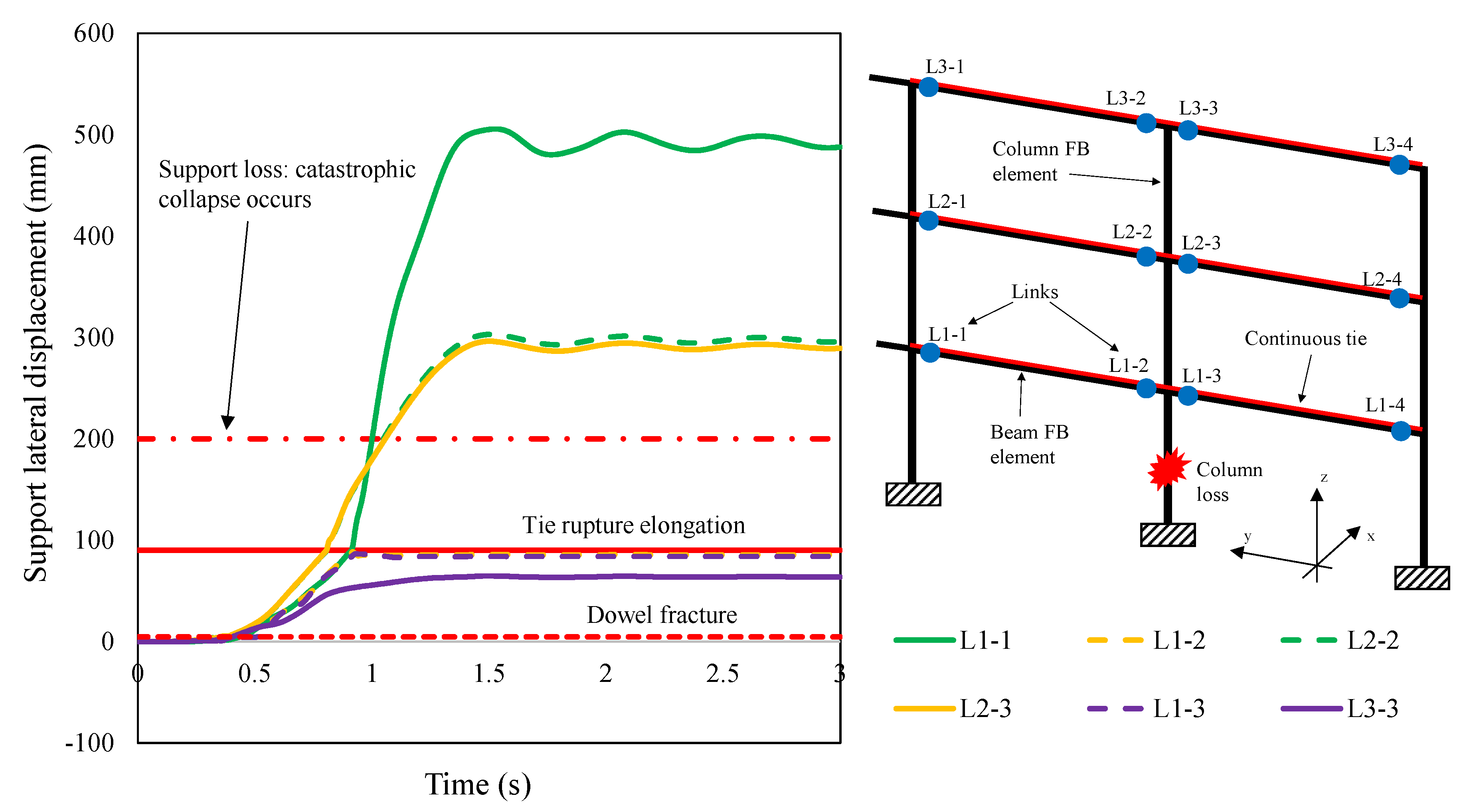
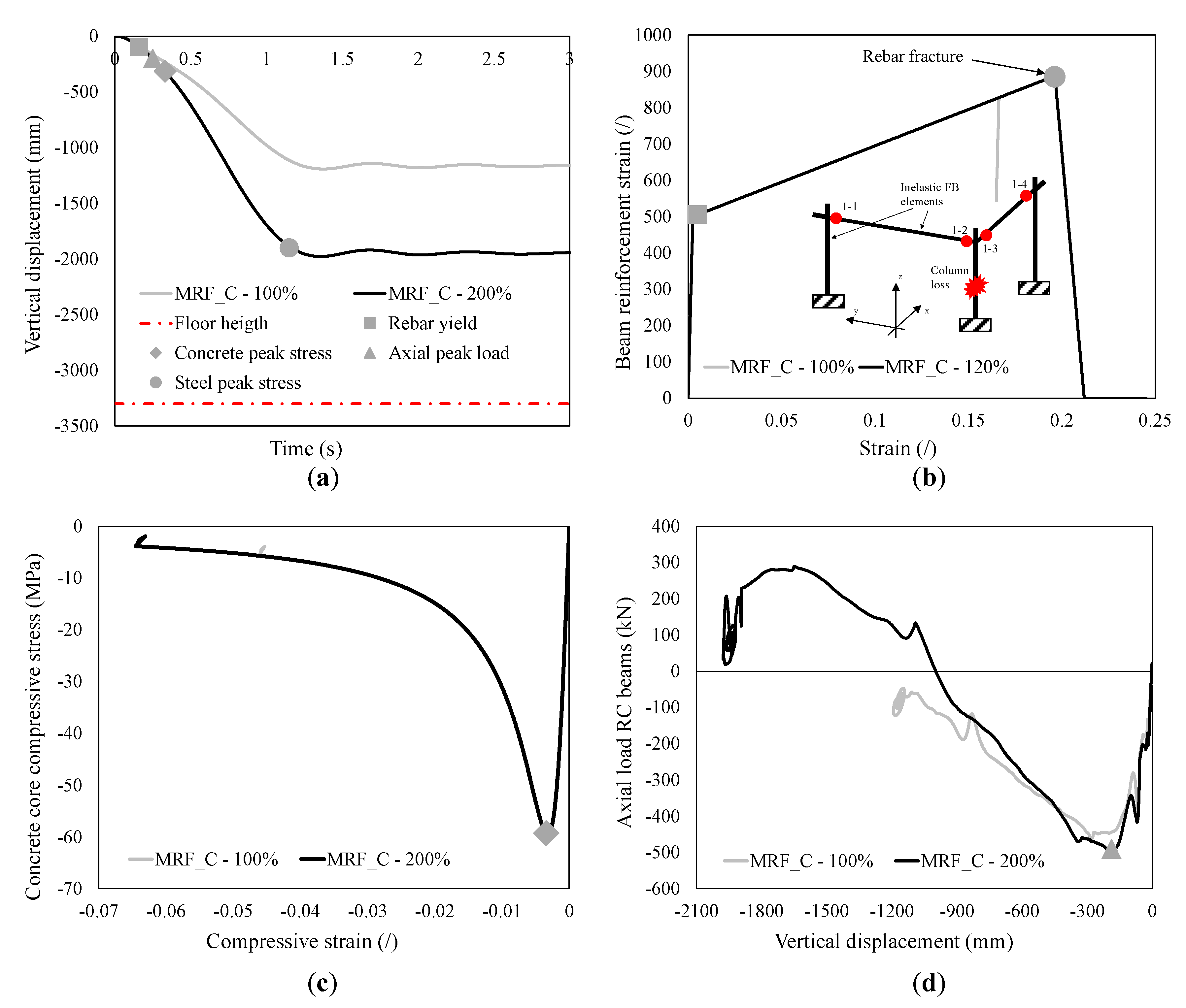

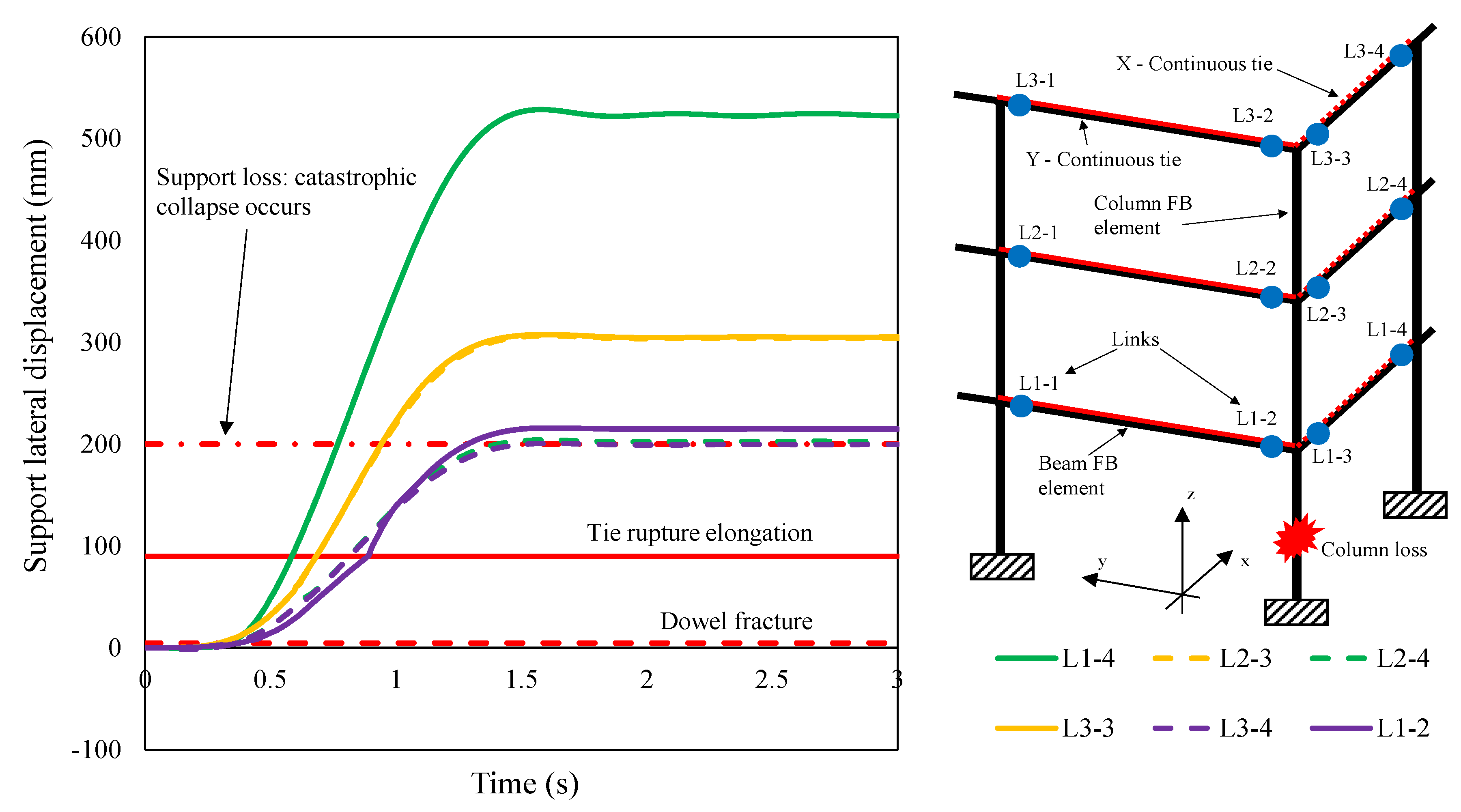
| Floor | Edge–Qb,e | Interior–Qb,i | Corner–Qb,c | Unit |
|---|---|---|---|---|
| 1st, 2nd | 47.50 | 69.70 | 47.50 | [kN/m] |
| 3rd | 19.00 | 38.00 | 19.00 | [kN/m] |
| Negative Moment Connection Strength | Dowel Shear strength | |||||
|---|---|---|---|---|---|---|
| θRcy [rad] | θRcu [rad] | MRcy [kN·m] | MRcu [kN·m] | ΔRdy [mm] | ΔRd [mm] | VRd [kN] |
| 0.0012 | 0.185 | 383.20 | 690.80 | 0.13 | 4.60 | 51.30 |
| Scenario | Model | PLS1 (t, Δ) | PLS2 (t, Δ) | PLS3 (t, Δ) | PLS4 (t, Δ) |
|---|---|---|---|---|---|
| Edge | PC1_E-90% | (0.25; −240) | (0.35; −500) | (1.00; −2200) | (1.20; −2300) |
| Interior | PC1_I-70% | (0.24; −225) | (0.34; −434) | (0.90; −2200) | (1.00; −2500) |
| Corner | PC_1-200%-1T | (0.25; −235) | (0.33; −290) | (0.80; −1800) | (0.85; −1650) |
| Scenario | Model | Load level | Δ (mm) | θL (rad)1 | θl (rad)2 |
|---|---|---|---|---|---|
| Edge | MRF | 170%·Qb,e | −3125.00 | 0.29 | / |
| PC_1 | 80%·Qb,e | −2200.00 | 0.20 | / | |
| PC_1 | 90%·Qb,e | −2300.00 | 0.21 | / | |
| PC_2 | Self-weight | −2060.00 | 0.19 | / | |
| Interior | MRF | 100%·Qb,i | −3180.00 | 0.29 | / |
| PC_1 | 60%·Qb,i | −2250.00 | 0.21 | / | |
| PC_1 | 70%·Qb,i | −2500.00 | 0.23 | / | |
| PC_2 | Self-weight | −1950.00 | 0.18 | / | |
| Corner | MRF | 200%·Qb,c | −1980.00 | 0.18 | 0.28 |
| PC_1-1T | 200%·Qb,c | −1650.00 | 0.15 | 0.23 | |
| PC_1-2T | 200%·Qb,c | −1800.00 | 0.17 | 0.25 | |
| PC_2 | Self-weight | −1650.00 | 0.15 | 0.23 |
Publisher’s Note: MDPI stays neutral with regard to jurisdictional claims in published maps and institutional affiliations. |
© 2021 by the authors. Licensee MDPI, Basel, Switzerland. This article is an open access article distributed under the terms and conditions of the Creative Commons Attribution (CC BY) license (http://creativecommons.org/licenses/by/4.0/).
Share and Cite
Ravasini, S.; Belletti, B.; Brunesi, E.; Nascimbene, R.; Parisi, F. Nonlinear Dynamic Response of a Precast Concrete Building to Sudden Column Removal. Appl. Sci. 2021, 11, 599. https://doi.org/10.3390/app11020599
Ravasini S, Belletti B, Brunesi E, Nascimbene R, Parisi F. Nonlinear Dynamic Response of a Precast Concrete Building to Sudden Column Removal. Applied Sciences. 2021; 11(2):599. https://doi.org/10.3390/app11020599
Chicago/Turabian StyleRavasini, Simone, Beatrice Belletti, Emanuele Brunesi, Roberto Nascimbene, and Fulvio Parisi. 2021. "Nonlinear Dynamic Response of a Precast Concrete Building to Sudden Column Removal" Applied Sciences 11, no. 2: 599. https://doi.org/10.3390/app11020599
APA StyleRavasini, S., Belletti, B., Brunesi, E., Nascimbene, R., & Parisi, F. (2021). Nonlinear Dynamic Response of a Precast Concrete Building to Sudden Column Removal. Applied Sciences, 11(2), 599. https://doi.org/10.3390/app11020599









